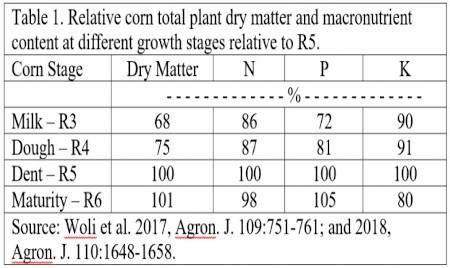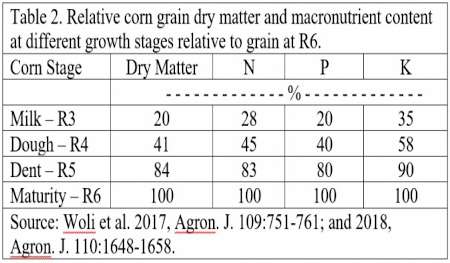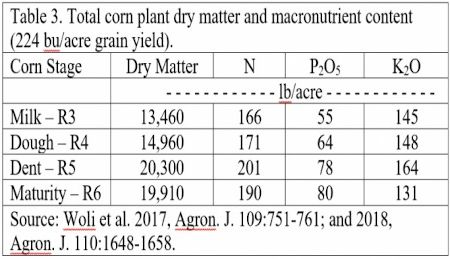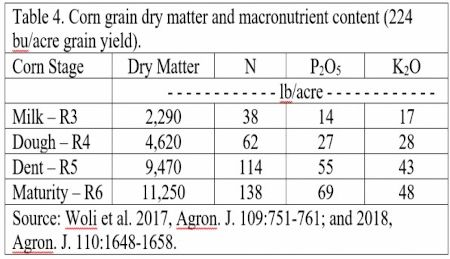By John Sawyer and Antonio Mallarino
The August 10, 2020 high winds (derecho) caused lodged or flattened corn in many Iowa fields. The corn development ranged mainly from stages R3 (milk) to R5 (dent). Some fields may not be harvested, some chopped for silage, and some harvested for grain. Nutrients such as nitrogen (N), phosphorus (P), and potassium (K) remaining in the field may be different than with normal harvest due to partial plant removal, grain harvest, or grazing. Therefore, adjustments can be made for future fertilizer or manure applications.
Effect of corn development stage
Iowa State University and Outreach publication PM 1688 (A General Guide for Crop Nutrient and Limestone Recommendations in Iowa) provides P and K concentrations for corn normally harvested for grain and corn silage. Additional information on dry matter and nutrient content of various corn vegetative components at maturity can be found in ICM News article Dry Fall Conditions Can Lead to Field Fires.
The corn plant P and K concentrations, as well as the N and dry matter concentrations, may differ with earlier growth stages. A recent ISU research study conducted across two years looked at the dry matter and nutrient content of several era corn hybrids. The following information is taken from the most modern hybrids in that study. Plant dry matter and nutrient content increases as reproductive stage and grain fill progresses (Tables 1 and 2). These values can be used as estimates/adjustments for the corn stage in specific fields. There tends to be nutrient loss from vegetative tissues as corn reaches maturity (R6 stage), therefore the total plant relative values are based on the total at R5. Such nutrient loss does not occur for grain, therefore, the grain relative values are based on the total at R6.



Total corn plant dry matter and nutrient uptake varies by productivity (yield level) and specific growing conditions (weather, hybrid, etc.). Tables 3 and 4 list the dry matter and nutrient content for the hybrids’ grain yield of 224 bu/acre. Of course, estimated nutrient amounts should be based on each field yield or harvested plant component and yield.

Key points
- With normal corn silage or grain harvest, considerations for nutrient management and application rates for the next crop will not be different compared to a normal year.
- For plant harvest at corn stages not normal for silage or grazing, P and K concentration estimates can be adjusted based on the growth stage. However, estimating the amounts of P and K remaining or removed will be difficult and uncertain with partial plant harvest or grazing.
- If the corn plants are broken off and die, and plant parts are not removed or grazed, then dry matter yield and P and K concentrations can be approximated based on the growth stage when killed (see Tables 1-4); and the P and K amounts remaining in the field will be available for future crops.
- Nitrogen remaining in non-harvested plant material will cycle through the soil system. If fields are rotated to soybean next year, changes in N recycling will not affect the soybean crop. If there is no plant material harvested, then there is potential for more than normal amounts of N to be available to next-year’s corn crop. However, that estimation should not be taken into account until the spring of 2021 as there needs to be time for N mineralization and there can be rapid change in inorganic-N (specifically nitrate) from late summer to the next spring.
Source : iastate.edu